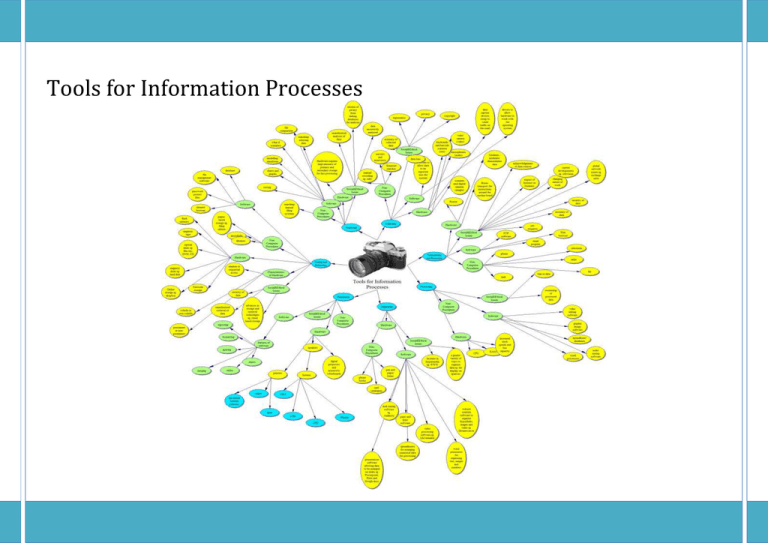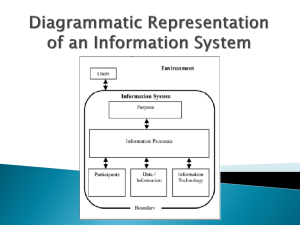ipt_prelim_summary_notes_organiser_topic2
advertisement

Tools for Information Processes Information Processes and Technology Preliminary Course Tools for Information Processes Students learn about: collecting • collecting – the process by which data is captured or entered into a computer system, including: – deciding what data is required – how it is sourced – how it is encoded for entry into the system • hardware used for collection (See Course Specifications Document) • software used for collection (See Course Specifications Document) • non-computer procedures in collecting – literature searches – surveys and interviews – form design for data collection – manual recording of events – existing non-computer data • social and ethical issues in collecting – bias in the choice of what and where to collect data – accuracy of the collected data – copyright and acknowledgment of source data when collecting – the rights to privacy of individuals on whom data is collected – ergonomic issues for participants entering large volumes of data into an information system Students learn to: • • • • • • • • • • • • • organising • organising – the process by which data is structured into a form appropriate for use by other information processes • how different methods of organising affect processing, for example: – letters of the alphabet represented as images rather than text – numbers represented as text rather than numeric • • • • the way in which the hardware used for collection organises data by digitising images, audio, video, numeric and text software for organisation (See Course Specifications Document) non-computer tools for organising – hard copy systems such as phone books, card catalogues and pen and paper forms – pen and paper methods for organising data social and ethical issues associated with organising, including: – current trends in organising data, such as: - the increase in hypermedia as a result of the World Wide Web - the ability of software to access different types of data for a given scenario, identify alternatives for data collection and choose the most appropriate one use a range of hardware collection devices to collect different data types describe the operation of a range of hardware collection devices make predictions about new and emerging trends in data collection based on past practices choose the most appropriate combination of hardware, software and/or non-computer tools to collect data from a given source use the Internet to locate data for a given scenario design forms that allow data to be accurately recorded and easily input into software applications select and use appropriate communication skills to conduct interviews and surveys so that data can be accurately collected identify existing data that can be collected for an information system for a given scenario recognise personal bias and explain its impact on data collection identify the privacy implications of particular situations and propose strategies to ensure they are respected predict errors that might flow from data inaccurately collected predict issues when collecting data that might arise when it is subsequently analysed and processed • choose the most appropriate format for a given set of data and identify and describe the most appropriate software and method to organise it • describe how different types of data are digitised by the hardware that collects it compare and contrast different methods of organising the same set of data using existing software applications use software to combine data organised in different formats use data dictionaries to describe the organisation of data within a given system assess future implications when making decisions about the way data is organised • • • • Summary Notes Questions Students learn about: Students learn to: - a greater variety of ways to organise resulting from advances in display technology – the cost of poorly organised data, such as redundant data in a database used for mail-outs analysing • analysing – the process by which data can be represented and summarised so that humans can better understand it • hardware requirements for analysing, including: – large amounts of primary and secondary storage allowing for fast processing – fast processors allowing many rapid calculations • software features for analysis, including: – searching/selecting data – sorting – modelling/simulations – what-if scenarios – charts and graphs to identify trends – file comparison • non-computer tools, for analysing, including: – searching manual filing systems – non-computer models and simulations • social and ethical issues associated with analysis, including: – unauthorised analysis of data – data incorrectly analysed – erosion of privacy from linking databases for analysis • • use software analysis features in a range of software applications to analyse image, audio, video, text and numeric data • compare and contrast computer and non-computer tools for analysis on the basis of speed, volume of data that can be analysed, and cost analyse data on individuals for the purpose it was collected • storing and retrieving • storing and retrieving – the two-step process by which data or information can be saved and reloaded to allow for: – other processing to take place – a temporary halt in the system – backup and recovery – the transfer of data or information • hardware for storing and retrieving – hardware devices (See Course Specifications Document) – the characteristics of hardware, including: - random or sequential access - volatile or non-volatile - permanent or non-permanent • the trend to faster and greater storage capacity over time software for storing and retrieving – hardware interface software – file management software – database management systems – file formats for different data types – Internet browser - used to access a machineindependent data store - using search engines to access data – encryption/password protection – security of stored data whether stored centrally or distributed non-computer tools, including: – paper based storage systems – microfiche – libraries social and ethical issues, including: – the security of stored data – unauthorised retrieval of data – advances in storage and retrieval technologies and new uses such as data matching identify hardware requirements to carry out a particular type of analysis describe the best organisation for data for a particular type of analysis • • • • document the storage and retrieval process in an information system describe the characteristics and operation of hardware devices used for storage and retrieval use a range of hardware devices and associated software to store and retrieve information and data store and retrieve data using a network compare different file formats for storing the same data, explaining the features and benefits of each use software features to secure stored data and information retrieve and use data in an ethical way Summary Notes Questions Students learn about: processing processing – a method by which data can be manipulated in different ways to produce a new value or result (eg calculating a total, filtering an email, changing the contrast of an image, changing the volume of a wave file) hardware in processing – hardware with fast processors, a lot of RAM and large storage capacity for image, video and audio processing – increased processing speed, by: - increased clock speeds - increased bus capacity – historical and current trends in CPU development software for processing text, numeric, image, video and audio data non-computer tools and processing – documenting procedures to be followed when processing social and ethical issues associated with processing – ownership of processed data – bias in the way participants in the system process data transmitting and receiving transmitting and receiving – the process that transfers information and data within and between information systems hardware for transmitting and receiving – communications within a computer between peripheral devices and the CPU via buses – the role of modems, including modulation and demodulation – local area networks and wide area networks software for transmitting and receiving – communications packages – transmitting and receiving text, numeric, image, audio and video – electronic mail and its operation non-computer tools for transmitting and receiving, such as mail, phone, fax and radio and television (transmit only) social and ethical issues associated with transmitting and receiving – accuracy of data received from the Internet – security of data being transferred – net-etiquette – acknowledgment of data source – global network issues, time zones, date fields, exchange rates – changing nature of work for participants, such as work from home and telecommuting – current developments and future trends in digital communications, radio and television – the impact of the Internet on traditional business Students learn to: select appropriate hardware configurations for a specified type of processing edit text data using word processors, desktop publishing, hypertext and database management systems edit numeric data using spreadsheets and database management systems edit image data using paint, draw and animation packages edit video data using animation packages edit audio data using mixing software diagrammatically represent data processing identify examples of potential human bias in data processing differentiate between the requirements for a local area network and a wide area network transfer numeric, text, image, audio and video data and discuss the time to transfer and required bandwidth describe concepts of downloading, uploading and streaming demonstrate sending and receiving mail, with attachments, over an e-mail system select a relevant technology for a given situation to allow computers to transmit and receive data or information compare and contrast computer and non-computer based communication systems describe and employ netetiquette when using the Internet predict and discuss possible future trends in communications and the impact they are likely to have on the transmitting and receiving of data/information Summary Notes Questions Students learn about: displaying displaying – the method by which information is output from the system to meet a purpose hardware for displaying (See Course Specifications Document) software for display – interfaces for hardware display devices – display features in applications packages, including: - reporting - formatting - spacing - merging - tables - charts non-computer tools: – traditional methods for displaying the different types of data Students learn to: social and ethical issues associated with displaying – communication skills of those presenting displays – past, present and emerging trends in displays – appropriate displays for a wide range of audiences, including: - standards for display for the visually impaired - displays suitable for young children integration of processes the interrelationships between the processes in a given system one tool (such as software to develop a multimedia presentation) may involve several processes choose and justify the most appropriate method for displaying information given a particular set of circumstances describe the operation of display hardware use a range of hardware and software combinations to display different types of information format a text document with appropriate use of fonts, spacing and layout for printed and screen displays design and develop a simple web page generate reports for display within a database mail-merge information from a database into another application for display create audio, image and video displays with presentation software compare and contrast displays created without a computer to those created with a computer identify, discuss and appreciate the widespread use of noncomputer methods of displaying information design a display for a wide variety of users recognise that processes can overlap, be concurrent or independent or not significant in a specific system Summary Notes Questions






